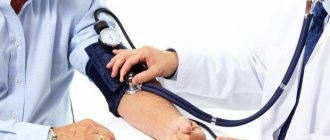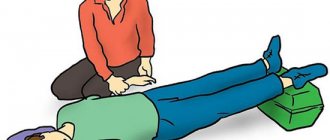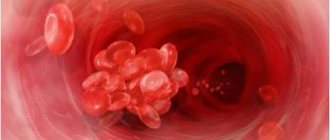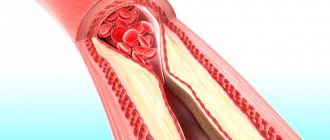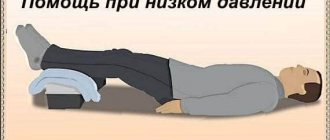Features of the cardiovascular system
The cardiovascular system consists of the heart, and veins and atria extending from it throughout the body. Heart contractions help build up pressure in the vessels to move blood. In the human body there is a large and small circle of blood circulation. The first moves blood through the aorta to the large arteries and capillaries.
The capillary network contributes to the saturation of cells with air and the intake of carbon dioxide.
The blood is then transported through small and large veins to the right atrium. The small circle of blood circulation originates from the right ventricle, from there the blood enters the pulmonary arteries, where oxygen saturation occurs. After which it enters the left atrium for further passage in a large circle.
Causes of vascular damage in children and adults
Vascular anomalies can be congenital or acquired. Intrauterine pathologies manifest themselves in the form of disturbances in the structure of the circulatory system.
After birth, anomalies occur under the influence of certain factors:
- Environment . People living in stuffy regions with high levels of air pollution are in a state of constant oxygen starvation, which leads to irreversible abnormal changes in the structure of blood vessels.
- Eating junk food . Excessive amounts of sugar in the blood lead to abnormal changes in many organ systems, including the cardiovascular system. Foods high in animal fats lead to the accumulation of harmful cholesterol in the blood, which causes blockage of blood vessels.
- Stress . With excessive emotional experiences, the body produces hormones that contribute to the appearance of vascular spasm.
- Obesity . Excess weight increases the stress on the cardiovascular system.
- Lack of movement . With insufficient physical activity, blood flow in the body slows down, which leads to hypoxia in areas distant from the heart.
- Tobacco smoking . The chemicals contained in cigarettes lead to poisoning of the body and vasospasm, which in turn contributes to the development of pathologies.
The state of blood flow is affected by pathologies of various organ systems, for example, anomalies of the musculoskeletal system, which lead to compression of certain areas of the blood vessels.
Thrombosis
This disease develops as a result of a violation of the inner surface of the venous wall of the deep veins. Factors that can lead to thrombosis include infection, chemical or mechanical injury, and an allergic reaction.
The risk of thrombosis also increases with high blood clotting and a resulting decrease in blood flow speed. Another prerequisite for the development of the disease is congestion in the veins of the lower extremities due to low physical activity or prolonged standing.
Note! Physical inactivity is the main factor leading to thrombosis. There are even such unscientific but common terms as “television thrombophlebitis” (prolonged sitting near the TV) and “economy class syndrome (long flights in an uncomfortable airplane seat).” When a person is in a sitting position with bent legs for many hours, blood stagnates in the deep veins, which provokes the development of pathology.
The danger of thrombosis lies in the following consequences:
- A blood clot in the lower leg (below the knee) is not as dangerous as one in the upper limb. The higher the blood clot rises, the wider the vein, and therefore the danger of the blood clot breaking off increases.
- If a clot travels to the heart or lungs, it blocks the blood flow there. Thromboembolism occurs, which leads to severe shortness of breath, cardiac arrest and even death.
- A blood clot that gets into the arteries of the brain causes a stroke.
Causes of blockage of blood vessels:
- increased blood viscosity due to lack of fluid in the body, as well as as a result of metabolic disorders or exposure to a malignant tumor;
- blood stagnation in the legs resulting from physical inactivity, varicose veins or inflammatory disease;
- pathologies of the circulatory system (thrombophlebitis, erythremia);
- genetic factor;
- infectious diseases (sepsis, allergies);
- pneumonia;
- excessive body weight;
- diabetes.
At the initial stage, the symptoms of the disease are usually mild. However, over time, more and more signs of thrombosis appear, including:
- swelling of the lower extremities;
- formations in the form of spider veins;
- change in skin color on the legs;
- convulsions, especially disturbing at night;
- pain in the thigh, leg and foot (pain subsides when the limb is horizontal);
- venous insufficiency;
- elevated temperature.
In the acute stage, thrombosis proceeds rapidly:
- venous outflow completely or partially stops;
- thighs and legs increase in size;
- the saphenous veins dilate noticeably;
- cyanosis occurs;
- the temperature rises to 38 degrees.
If the disease is asymptomatic, the fact that the patient is suffering from thrombosis can be guessed by distinct venous collaterals in the lower abdomen, leg and thigh.
Based on the results of the examination and tourniquet tests with an elastic bandage, the phlebologist determines the patient’s condition. Phlebography, duplex scanning, ultrasound examination of veins, and rheovasography of the lower extremities are prescribed as diagnostic measures.
The choice of treatment tactics depends on the stage of the disease, the general health of the patient, and the location of the pathology. The main goal is to avoid the spread of thrombosis, as well as to prevent pulmonary embolism (that is, blockage of the arteries of the lungs).
Treatment is carried out only in a hospital setting. The patient is prescribed strict bed rest and medications, including anticoagulants, thrombolytic and fibrinolytic drugs, as well as antiplatelet agents. The operation is performed in case of threat to the patient's life.
Treatment methods for deep vein thrombosis:
- Drug therapy. Taking medications reduces the activity of symptoms and normalizes blood flow. The action of coagulants (Coumadin, Heparin, Warfarin) is aimed at reducing blood density and preventing thrombosis in the vessels and veins of the legs, as well as reducing swelling. Thrombolytic agents (Trypsin, Chymotrypsin) eliminate blood clots. Phlebotonics counteract blood stagnation in the extremities and improve vascular tone (Detralex, Venosmin). Non-steroidal anti-inflammatory drugs are aimed at eliminating pain and reducing swelling in the legs (Diclofenac, Indomethacin).
- Surgery. The operation is indicated in case of danger of blood clot rupture or thrombophlebitis. Techniques such as vena cava filters, Troyanov-Trendelenburg surgery, and thrombectomy are used. Surgery is contraindicated at the stage of exacerbation of the disease and in certain cardiovascular pathologies.
- Traditional medicine. Traditional therapy acts only as an auxiliary remedy that alleviates the course of the disease. Herbal tinctures and foot baths based on nettle, horse chestnut, and chamomile are used.
Depending on the patient's health condition, the doctor may recommend moderate exercise, including walking and therapeutic exercises. Activities with a high load on the feet, as well as thermal procedures (sauna, steam bath, hot baths) should be completely excluded from the patient’s life.
Factors predisposing to pathology
Problems with blood vessels are manifested under the influence of the following factors:
- high blood pressure;
- age after 40 years;
- pathologies of the cardiovascular system in blood relatives;
- diabetes mellitus of any type;
- alcoholism;
- excessive physical activity;
- lack of normal sleep;
- consumption of certain medications;
- the amount of cholesterol in the blood is above 5.5 mmol/l.
Impaired functioning of the cardiovascular system can develop during pregnancy, as it leads to an increased load on all organ systems.
What does the localization of vein lesions indicate?
Damage to areas of the circulatory system leads to various consequences, which directly depend on the location of the pathology.
Head
Impairment of blood flow in the brain progresses gradually, and manifests itself in the form of:
- dizziness;
- drowsiness;
- increasing feeling of fatigue;
- decreased concentration;
- memory impairment;
- recurrent headaches;
- frequent mood changes;
- decreased performance;
- lack of coordination;
- inability to control bowel movements and urination.
Abnormal vascular changes lead to the death of brain cells, which can cause death or severe neurological complications.
Neck
Problems with the vessels of the neck have the same manifestations and consequences as with pathological conditions in the brain. With the exception that a disorder in the structure of the cervical arteries has more pronounced symptoms.
Coronary arteries
The coronary artery is responsible for supplying blood to the heart muscle.
With its pathologies, blood flow is impaired, manifested by the following symptoms:
- increased fatigue;
- prostration;
- increased heart rate with little physical activity;
- pain in the chest area, aggravated by physical or emotional stress;
- shortness of breath in the absence of vigorous activity.
Problems with blood vessels have different symptoms: shortness of breath, severe fatigue, loss of strength.
Constant hypoxia and lack of nutrients that occur with pathologies of the coronary artery can cause death, as they lead to the death of heart cells.
Upper limbs
Impaired blood flow in the hands leads to:
- numbness of the last phalanx of the fingers;
- the appearance of tingling in the limbs;
- painful sensations;
- changes in the skin, manifested in pallor and peeling;
- hair loss and disruption of the structure of the nail plates.
Most often, atherosclerosis leads to problems with blood vessels.
Legs
Disturbances in the vessels of the legs are accompanied by the same manifestations as with damage to the upper extremities, but have additional symptoms.
For example:
- lameness;
- soreness;
- swelling.
Lack of timely treatment can lead to tissue necrosis and amputation of limbs.
Heart
Violation of the condition of blood vessels in the heart leads to an abnormality in the coronary circulatory system, which in turn contributes to insufficient supply of air and nutritional components to the myocardium.
When blood circulation is impaired, normal myocardial cells are replaced by scars, which leads to a malfunction of the heart.
Symptoms of damage to the blood vessels of the heart muscle:
- weakness;
- arrhythmia;
- increased breathing and heart rate;
- swelling of the lower extremities;
- change in mood.
If therapy is refused, myocardial infarction develops.
How do vascular disorders manifest themselves?
Signs of dysfunction of the circulatory system can be very diverse. The symptoms of the disease depend, first of all, on the predominant localization of the lesion. In addition, it is important to find out the cause of the problems.
Note! Isolated lesions at a specific location are rare. As a rule, problems with arteries and veins are observed throughout the body.
Any lesion is very dangerous, because it leads to insufficient blood supply to the internal organs.
Some of the main causes of artery problems include:
- Atherosclerosis is a systemic disease associated with the deposition of cholesterol molecules on the inner wall of blood vessels and the formation of fatty plaques. As the disease progresses, their lumen becomes increasingly closed, and the patient exhibits signs of ischemia of the internal organs.
- Arterial hypertension is a disease accompanied by a disruption of the nervous and humoral regulation of vascular tone. Like atherosclerosis, it is characterized by narrowing (spasm) of the arteries and various disturbances in the uninterrupted blood supply to tissues.
- Osteochondrosis is a pathology manifested by degeneration and proliferation of intervertebral cartilage, causing compression of the arteries and deterioration of blood flow (usually in the cervical and head regions).
Venous disorders develop with varicose veins, phlebitis and thrombophlebitis.
- frequent stress;
- hypoxia caused by the need to stay in a stuffy room for a long time, living in regions with unfavorable environmental conditions;
- smoking, alcohol abuse.
Frequent stress negatively affects cardiovascular health
Head and neck
Problems with the blood supply to the head and neck usually develop gradually. The main clinical manifestations of these pathologies are presented in the table below.
| Degree of pathological changes | Signs |
| I (initial) |
|
| |
| |
| |
| |
| II (moderate) |
|
| |
| |
| |
| III (severe) |
|
| |
|
Note! An acute disruption of blood flow to the central nervous system causes irreversible neuronal death. At the same time, the existing signs of cerebral vascular pathologies are accompanied by the development of paralysis, paresis, speech impairment and other serious complications.
Circulatory disorders may have their own characteristic features associated with the localization of arterial stenosis. Problems with the arteries of the neck (for example, the common carotid) have more pronounced symptoms.
Coronary arteries
Poor circulation in the coronary arteries is accompanied by symptoms of angina pectoris.
It manifests itself:
- Increased fatigue, tiredness;
- Decreased tolerance to physical activity;
- Aching, pressing, squeezing pain behind the sternum, appearing during physical activity or psycho-emotional stress;
- Shortness of breath.
Angina pectoris is a consequence of ischemia of cardiac tissue
An important acute complication of problems with the coronary arteries is myocardial infarction – necrosis (irreversible death) of a section of the heart muscle, leading to the development of heart failure and even death.
Limbs
Often in medical practice there are cases of peripheral circulatory disorders.
Problems with the peripheral arteries of the arms and legs manifest themselves:
- numbness of fingertips;
- cold extremities;
- paresthesia: tingling sensation, crawling “goosebumps”;
- pain in the limbs;
- severe pallor and dryness of the skin;
- trophic disorders - hair loss, thinning, brittle nails, peeling of the skin.
Atherosclerosis remains the main cause of circulatory disorders in the legs
Problems with the arteries in the legs are additionally accompanied by intermittent claudication, a complex symptom that includes sharp pain in the legs and the inability to continue moving when walking a certain distance.
Significant circulatory disorders can cause severe irreversible complications - trophic ulcers or gangrene of the distal limbs.
Symptoms of vascular problems
Minor changes in the structure of arteries and veins may not cause negative manifestations.
In its advanced form, dysfunction of the cardiovascular system provokes the occurrence of:
- stable increase in blood pressure;
- lipid metabolism disorders;
- neurocirculatory-vascular dystonia;
- varicose vein structure;
- phlebitis;
- thrombophlebitis;
- cerebral vascular crises;
- necrosis of myocardial tissue;
- ischemic stroke;
- migraines or migraine attacks;
- heart failure;
- IBS.
Symptoms differ depending on the location of the affected vessel.
The most common manifestations are:
- systematic pain in the head area;
- dizziness;
- severe pain, a feeling of pulsation in the area of the cervical artery and darkening of the eyes with a rapid change in position;
- impaired sensitivity of the limbs;
- feeling of coldness in the hands or feet;
- poor health due to sudden changes in weather;
- blood pressure surges;
- changes in heart rate;
- loss of consciousness;
- discomfort at elevated room temperatures;
- periodic pain in the head area of a pulsating nature.
If one or more of the listed symptoms occurs, you should immediately see a specialist.
How does the pathology of the cervical vessels manifest?
The key point in the development of symptoms is considered to be a decrease in blood flow parameters and hypoxia (oxygen starvation), which is experienced primarily by the brain, which does not receive the amount of nutrition it needs. Symptoms of insufficiency of arterial blood supply can gradually increase, disturbing for years, and then the patient has time to diagnose and take appropriate treatment measures.
An unfavorable development of events is acute forms of pathology with complete occlusion of neck vessels or embolism from them, when smaller cerebral arteries are blocked. In this case, not only focal signs of brain damage are likely, but also swelling and death of the patient.
It is worth noting once again that the symptoms of damage to the vessels of the neck occur when the lumen is stenosis by at least 50%; up to this point, the signs are either absent or expressed to a degree that few people will pay serious attention to.
Symptoms of vascular damage to the neck with impaired blood flow in the brain are:
- Headaches and dizziness;
- Weakness, flashing “spots” before the eyes;
- Weakening of memory, difficulties in performing professional tasks, fatigue;
- Sleep disorders;
- Changes in the emotional sphere and behavior - irritability, tearfulness, tendency to apathy and depression, anxiety.
These symptoms are familiar to many older people suffering from atherosclerosis. They constitute manifestations of discirculatory encephalopathy, which in old age may well “develop” into severe dementia with the absolute impossibility of independent life, a sharp decrease in intelligence, paresis and even paralysis.
In contrast to chronic cerebral ischemia, which increases over a long period of time with pathology of the vessels of the neck, acute disturbances of blood flow in the brain are possible - strokes such as necrosis (infarction) against the background of embolism, thrombosis, prolonged spasm of already changed arteries.
An acute disturbance of blood flow in the brain is manifested by focal neurological symptoms - paralysis of the limbs, muscle atony, areflexia, difference in pupil diameter, speech disorders, hearing, vision, etc. With deep damage to the brain and increasing edema, coma develops and the patient dies.
Which doctor should I contact?
In case of pathology of the cardiovascular system, you should contact a therapist, he will make a primary diagnosis and refer you to another specialist for a more detailed examination.
| Symptoms | The specialist you should contact |
| Pain in the neck and head, extraneous sounds in the ears, constant feeling of fatigue, loss of consciousness, disturbance of orientation in space. | Neurologist |
| Protrusion of veins, swelling, pain in the lower extremities, spider veins, venous stenosis. | Phlebologist |
| Painful sensations in the chest area, irregular heart rhythm, increased sweating, irregular breathing. | Cardiologist |
| Decreased sensitivity of the skin, tingling of the fingers, pain and decreased mobility of the limbs. | Angiologist |
Without timely treatment, any pathology of the cardiovascular system can lead to serious complications.
Why is there a problem?
The blood vessels of the neck and head perform a vital function.
They deliver oxygen and nutrients to the brain, ensuring its normal functioning. Cerebrovascular accident occurs for the following reasons:
- deformation of blood vessels;
- slagging;
- accumulation of atherosclerotic plaques;
- spasm and contraction.
For these reasons, the elasticity and permeability of the walls decreases.
Such problems appear as a result of an unbalanced diet, when the diet contains a huge amount of fatty and spicy foods, regular stress, excessive physical and emotional stress, cardiovascular diseases and traumatic brain injuries. Also, the cause may be osteochondrosis of the cervical spine, which leads to pinching of the vessels of the neck.
The causes of cerebral vasospasm include the following:
- Overwork. When a person works too much while sitting at a computer, for example, the blood supply to the brain deteriorates and vasospasm occurs.
- Lack of sleep. The brain, like any other organ of the body, needs to rest. His fatigue due to lack of sleep is expressed, among other symptoms such as headache, also in the onset of vasospasm.
- Lack of oxygen. The nutrition of the brain deteriorates, to which the blood vessels react first. You need to spend more time in the fresh air and ventilate the room in which you spend most of your time.
- Smoking. In a person who smokes more than a pack of cigarettes per day, the likelihood of vascular spasms in the head increases many times over compared to a non-smoker.
- Various diseases and conditions:
- (accompanied by noise and ringing in the ears, shortness of breath, a feeling of weakness in the heart, coldness in the extremities);
- Cardiac dysfunction (shortness of breath, ):
- Disorders of the thyroid gland;
- Renal dysfunction;
- (through which the arteries that supply blood to the brain pass).
In addition, the most ordinary everyday situations can provoke a spasm in the head, for example, when a person is in the cold for a long time with his head uncovered, if he has drunk more alcohol than he can afford; if you experienced short-term stress (for example, you had an argument with someone at home or at work).
Any strong emotion can cause a spasm - not only negative, but also positive. Indian yogis recommend generally abstaining from strong emotions, since they “shatter” all systems of the body. And the brain is no exception. So, wanting to avoid spasm of cerebral vessels, which is fraught with such a terrible disease as, try not to worry, especially over trifles.
Diagnostic principles
Problems with blood vessels can only be identified with a complete examination. A visual inspection will not give any results.
Duplex sography
Duplex scanning combines ultrasound diagnostics and Doppler ultrasound. This research method allows us to identify vascular pathologies at an early stage of development, as it allows us to evaluate the structure of the veins and identify internal disorders.
During the procedure, a two-dimensional image of veins and arteries is displayed on one monitor window, which makes it possible to determine their structural abnormalities, and on the second, a color display of blood flow. The blood flow coming from the sensor is shown in blue, and the blood flow towards it in red.
EchoCG
Echocardiography is an ultrasound examination aimed at identifying structural pathological changes in the structure of the heart.
The method under consideration allows:
- assess the condition of soft tissues;
- determine the thickness of the heart walls;
- assess the condition of the heart valves;
- see the work of the heart in real time;
- view the features of blood flow in the heart.
This method does not allow you to see the work of the entire cardiovascular system.
Angiography
Angiography means a complex of contrast studies of blood vessels. The procedure allows damaged areas of veins and arteries in any organ and area of the body.
Thanks to this method, it is possible to identify at an early stage:
- aneurysms;
- narrowing of blood vessels;
- malformations;
- violation of the patency of veins and arteries;
- pathological conditions of organs;
- tumors of various origins.
Timely diagnosis allows you to avoid serious complications.
CT scan
The procedure allows us to identify pathological conditions of the cardiovascular system associated with age-related changes, inflammation or injury. Each part of the body is examined separately, but the principle of the procedure is identical. Connected to the monitor, the scanning device transmits a layer-by-layer image to the screen, from which even minor abnormal changes can be seen.
Magnetic resonance imaging
MRI allows you to quickly and accurately identify any pathological processes in blood vessels. MRI angiography is aimed at examining vessels located in any part of the human body, but is most often used to identify pathologies in the brain or cervical region.
To study the condition of blood vessels, devices with a magnetic field power of at least 0.3 Tesla are used.
Magnetic resonance imaging of blood vessels is performed using a contrast agent to obtain a more accurate result. In some cases, contrast may not be used.
Lab tests
To identify pathologies of the cardiovascular system, you should undergo laboratory tests:
- UAC. A blood test can reveal hemoglobin levels, the presence of inflammatory reactions and pathological blood conditions.
- Coagulogram . A method aimed at blood clotting indicators.
- Lipidogram . The procedure determines cholesterol levels and the proportion of lipid complexes in the blood.
Deviation according to any of the presented research methods may indicate the presence of vascular disorders.
Types and symptoms
Obliterating endarteritis
The pathology usually affects large vessels in the legs. It has been noticed that most patients are smokers, especially men. Endarteritis is a narrowing or complete closure of the arteries of the legs, which impairs bleeding in the affected area. The disease is expressed by the following symptoms:
- severe pain syndrome;
- heaviness when walking;
- lameness;
- pallor and swelling of the legs;
- convulsions;
- dry skin;
- stopping hair growth.
Varicose veins
Dilation of the vessels of the lower extremities is accompanied by swelling, fatigue, and cramps.
The most common foot disease. Due to flabbiness of the walls of blood vessels and dysfunction of the valves, blood does not circulate upward, but accumulates in the veins. Varicose veins lead to stretching of the veins and the appearance of nodes under the skin. The main symptoms include:
- pain and swelling of the legs;
- cramps at night;
- the presence of a vascular network;
- itching, peeling and dry skin.
Advanced varicose veins lead to atherosclerosis of the arteries, which develops slowly. The pathology is a complete or partial blockage of the arteries of the legs with cholesterol plaques.
Phlebitis of the lower extremities
This is the appearance of inflammatory processes in the walls of the veins. The disease appears against the background of already existing vascular disorders. The form of the disease can be acute or chronic. Symptoms of phlebitis:
- the vein becomes hard and increases in size;
- hyperemia of the skin appears;
- the temperature of the affected area rises;
- swelling and discomfort occurs in the leg.
Thrombophlebitis
Increased blood viscosity affects the condition of blood vessels due to the formation of clots and can result in death.
The disease develops with a combination of increased blood viscosity, inflammation of the vein and the formation of blood clots. It is considered a dangerous pathological condition, since a blood clot can break away from the vessel wall and enter any part of the circulatory system. Thrombosis causes blood circulation to stop and can be fatal if a pulmonary artery becomes blocked. The disease is characterized by the following symptoms:
- dizziness;
- malaise;
- weakness;
- pain that increases with activity or movement;
- redness of the area of skin where the vein is affected;
- increase in the volume of the sore leg.
Vein thrombosis
The disease is a blockage of deep blood vessels by a thrombus. Symptoms:
- bursting pain, mainly in the evening;
- heaviness in the legs;
- the appearance of swelling and numbness;
- thinning of the skin of the affected area;
- glossy shine of the skin;
- local and general hyperthermia;
- the appearance of a venous network;
- pale skin with a blue tint;
- convulsions;
- compressive pain syndrome.
Treatment methods
Restoration of blood circulation is carried out comprehensively. After a full examination, a specialist may prescribe medication, surgery or alternative treatment.
Drugs
Drug therapy is prescribed by the attending physician depending on the diagnosis:
- In case of atherosclerotic changes, the use of lipid-lowering drugs aimed at restoring fat metabolism is indicated.
- For varicose veins - venotonics.
- For hypertension, medications to restore normal blood pressure.
Folk remedies
To normalize blood circulation in the extremities, it is recommended to use tincture of mint and thyme. To prepare it, you need to brew 200 ml of hot water and 60 g of dried herbs. Infuse the resulting mixture for at least 10 hours.
The drug should be taken 20 ml before each meal.
To maintain the condition of blood vessels throughout the body, experts advise using a decoction of nettle or chamomile. You should also consume a mixture of equal proportions of honey, lemon juice and mint after meals, one tablespoon at a time.
Massage
Problems with the condition of blood vessels can be solved by massage, but its use is not permitted for all types of pathologies. Before starting this method of therapy, it is recommended to visit a specialist and undergo a full examination.
In acute forms of the disease, massage is strictly contraindicated. The exception is the acute form of hypertension and peripheral vascular patency. As a rule, the considered method of therapy is prescribed during the rehabilitation period, after exacerbation of chronic pathologies of the cardiovascular system.
Physiotherapy
To treat affected vessels, specialists may prescribe physical therapy.
The most effective are:
- electrophoresis;
- darsonvalization;
- ultratonotherapy;
- UHF therapy;
- magnetic therapy;
- laser therapy.
As a rule, the method of therapy under consideration is used for circulatory problems in the extremities or cervical region.
Principles of nutrition
The therapeutic diet is aimed at reducing stress on the cardiovascular system. To improve the condition of veins and arteries, it is necessary to regularly consume large amounts of plant-based foods.
Animal fats lead to increased cholesterol levels, so it is recommended to either avoid them or reduce their consumption to a minimum. You also need to reduce the amount of simple carbohydrates.
You need to add to your daily menu:
- seafood;
- seaweed;
- mushrooms;
- vegetables;
- fresh berries and fruits;
- ginger.
Proper nutrition will not only help normalize the condition of blood vessels, but will also help solve a number of other health problems.
Lifestyle
Vascular problems can be eliminated by lifestyle changes.
Experts recommend:
- give up alcoholic drinks and cigarettes;
- increase the level of physical activity;
- take daily walks in the fresh air;
- maintain a sleep-wake schedule;
- minimize stressful situations.
In the early stages of pathology development, you can do without drug treatment.
Treatment and self-medication
To prevent and treat vascular problems, collaboration with a doctor is important, especially if you have hypertension or VSD. The first and main therapeutic method is nutritional adjustment, regardless of the use of vasodilator drugs.
Measures to lower blood pressure:
- nutrition adjustments;
- to give up smoking;
- regular movement, physical activity;
- mandatory rest after work;
- regular consultations with your doctor.
Improved nutrition
Reduce your salt intake. The average person consumes 10 grams of salt per day. The maximum recommended daily dose of salt is 5 g. This is approximately 1 tsp, including all salt in foods. A beneficial result of reducing the amount of salt will be a decrease in blood pressure and an improvement in the effects of antihypertensive medications.
How to normalize blood vessels by reducing salt intake:
- When cooking, use a minimum of salt. Remove the salt shaker from the dining table.
- Replace salt with spices, herbs, mushrooms.
- Include low-salt foods in your diet, such as fruits and vegetables. Eat them fresh.
- Monitor the salt content on food packages. Beware of canned food, semi-finished products, instant soups, processed cheese, and smoked foods. Potato chips, salted nuts, and ready-made sauces (soy, tartar) also have a high salt content.
- Scientists have proven that a diet with a predominance of vegetables, fruits, and low-fat dairy products can reduce blood pressure by 11 mmHg.
- Start your day with breakfast. The ideal way to tidy up your blood vessels is to have a breakfast of fruit, low-fat milk or yogurt.
- Fortify every meal with vegetables. Eat a fresh vegetable salad with yogurt dressing or cheese at every meal. Prepare steamed vegetables as a side dish. Add fresh or frozen vegetables to soups. Eat tomatoes, bell peppers, and grilled mushrooms.
- Don't skip snacks. Eat homemade yogurt and fresh fruit. Another good option to maintain vascular tone is fruits, unsalted nuts, hard cheese. A low-fat latte (coffee with 2/3 milk) is suitable as a drink, incl. cafein free.
- Whole grain cereals only. Discover the taste of whole grain bread, pasta, and natural rice.
- Eat healthy desserts. Sweet cravings can be satisfied with pieces of fresh or dried fruit. Also try a smoothie made with banana and low-fat milk.
Fats
One of the risk factors for heart disease is poor blood vessels. What to do to strengthen them? First of all, unsaturated fatty acids contained in vegetable oils and fish oil are important. They should make up about 2/3 of the fat consumed.
Only 1/3 of the fats should be saturated fatty acids, such as butter and dairy products, lard, pork, and beef. This amount is usually covered by the consumption of hidden fats (cream, cheese, smoked meats, baked goods), so when cooking, use only vegetable oils.
A favorable ratio of fat intake reduces the risk of cardiovascular disease.
Alcohol
The negative effects of excessive alcohol consumption are obvious (effects on the stomach, liver, pancreas, alcoholism...). It has been shown that regular consumption of small amounts of alcohol (1 can of beer, 100-200 ml of wine or 30-60 ml of strong alcohol) has a beneficial effect on the walls of blood vessels in healthy people and reduces pressure in the eyes. But in people with hypertension, the situation is the opposite - alcohol directly increases blood pressure, damages the walls of the arteries, making them thin, which makes treatment difficult.
To give up smoking
Nicotine vapors provoke constriction and narrowing of blood vessels, which increases blood pressure. Smoking contributes to the development of stroke and myocardial infarction. There is no “safe” dose of cigarettes. Even 1 cigarette a day doubles the risk of a heart attack. Long-term smoking reduces life expectancy by an average of 14 years. Nicotine also harms the health of others, incl. children.
Active movement
Along with drug treatment, movement is an important factor in preventing vascular disorders. The simplest advice is 30 minutes of daily walking (eg walking to work), which reduces the risk of heart and vascular diseases by 30%. Walk so fast that you can talk while walking, but not sing.
You can choose other physical activity, such as cycling, swimming, tennis, dancing. Move for at least 30 minutes every day. Working in the garden and cleaning the house also helps maintain healthy blood vessels.
Physical activity will provide better health, reduce fatigue, improve stress resistance, support heart function, lower blood pressure, body weight, and cholesterol concentrations.
If you have heart disease or have been inactive for a long time, it is best to talk to your doctor about a suitable sports program.
Relaxation
Excessive excitement and stress also harm blood vessels and the heart. Getting enough exercise and regular sleep will help you cope better with these situations. Relax, go into nature, read, engage in hobbies.
Visit your doctor regularly
The doctor will recommend how to treat vascular disorders. The therapeutic approach depends on blood pressure, age, other diseases such as excess weight, diabetes, heart disease, and medications taken.
A dietitian will help you adjust your diet according to your current condition.
Possible consequences of vein problems
Vascular abnormalities provoke the development of irreversible pathological changes in the body:
- hypertension;
- ischemic disease;
- heart attack;
- stroke;
- trophic ulcers;
- gangrene;
- death.
Timely examination and treatment will prevent the development of serious complications.
Prevention
To prevent the development of vascular pathologies or prevent their progression, the following recommendations must be followed:
- Proper nutrition and healthy lifestyle . With the correct ratio of fats, proteins and carbohydrates, the load on blood vessels is reduced. Giving up bad habits allows you to maintain the correct structure of blood vessels for a long time.
- Sports . With moderate physical activity, the entire body strengthens.
- Medicines only as prescribed by a specialist . Uncontrolled use of pharmacological agents can cause irreparable harm to the body.
- Maintaining a sleep schedule . To maintain health, an adult needs to sleep at least 8 hours a day.
- Cold and hot shower . Water procedures with a sharp change in temperature can improve the elasticity of blood vessels and generally strengthen the body.
In order to promptly identify emerging abnormalities of the cardiovascular system, it is necessary to undergo a preventive examination by specialized specialists once every 6 months. At the same time, it is necessary to take a general blood test to identify any changes in the composition of the blood.
Any problems associated with changes in blood vessels can cause irreparable harm to the body. If you have a disease, self-medication is strictly prohibited. Preventive measures will allow you to maintain health for many years, preventing the occurrence of diseases.
Article design: Oleg Lozinsky
Traditional methods
Various internal remedies are used, as well as vascular exercises.
The simplest option: drink a glass of hot water in the morning on an empty stomach.
One of the best folk remedies for restoring the tone of the blood vessels of the cervical region and head is given below.
So, the recipe: take fresh or dried, but always young pine shoots. Place 25 cones in a pan, pour in about 1.5 liters of boiling water, cover with a lid and leave for three hours. If the buds have not become soft, they can be boiled until soft over low heat, but usually young fruits soften on their own after three hours in boiling water. Add four lemons minced in a meat grinder, a kilogram of sugar, bring to a boil and turn off.
It is preferable to use honey, then it should be introduced after the lemons and buds have cooled. The product is taken one tablespoon at a time with each meal. During the period of treatment with this remedy, you must definitely drink tea brewed with hawthorn fruits and field clover flowers.
Another remedy: chop 200 grams of figs, dried apricots, raisins, prunes and twenty walnut kernels, add honey, and store in a jar in the refrigerator. Take a spoonful morning and evening. The product perfectly strengthens vascular walls.
It is useful to use deyasil root infused with vodka. Aging period – 40 days. Take one dose per day, 25 drops per hundred grams of water.
Remember that many diseases of the blood vessels of the brain and neck can be overcome, but for this a person must want to live and fight, because neither taking medications, nor surgery, nor the doctor’s instructions can turn the situation around if you do not change your lifestyle.
Vessels
Arteries of the Head and Neck: Anatomy, Diagram, Atherosclerosis
Feb 06, 2020 Kokh V. A.
16582
Vessels
Transverse Cervical Artery
Feb 06, 2020 Kokh V. A.
8341
Vessels
